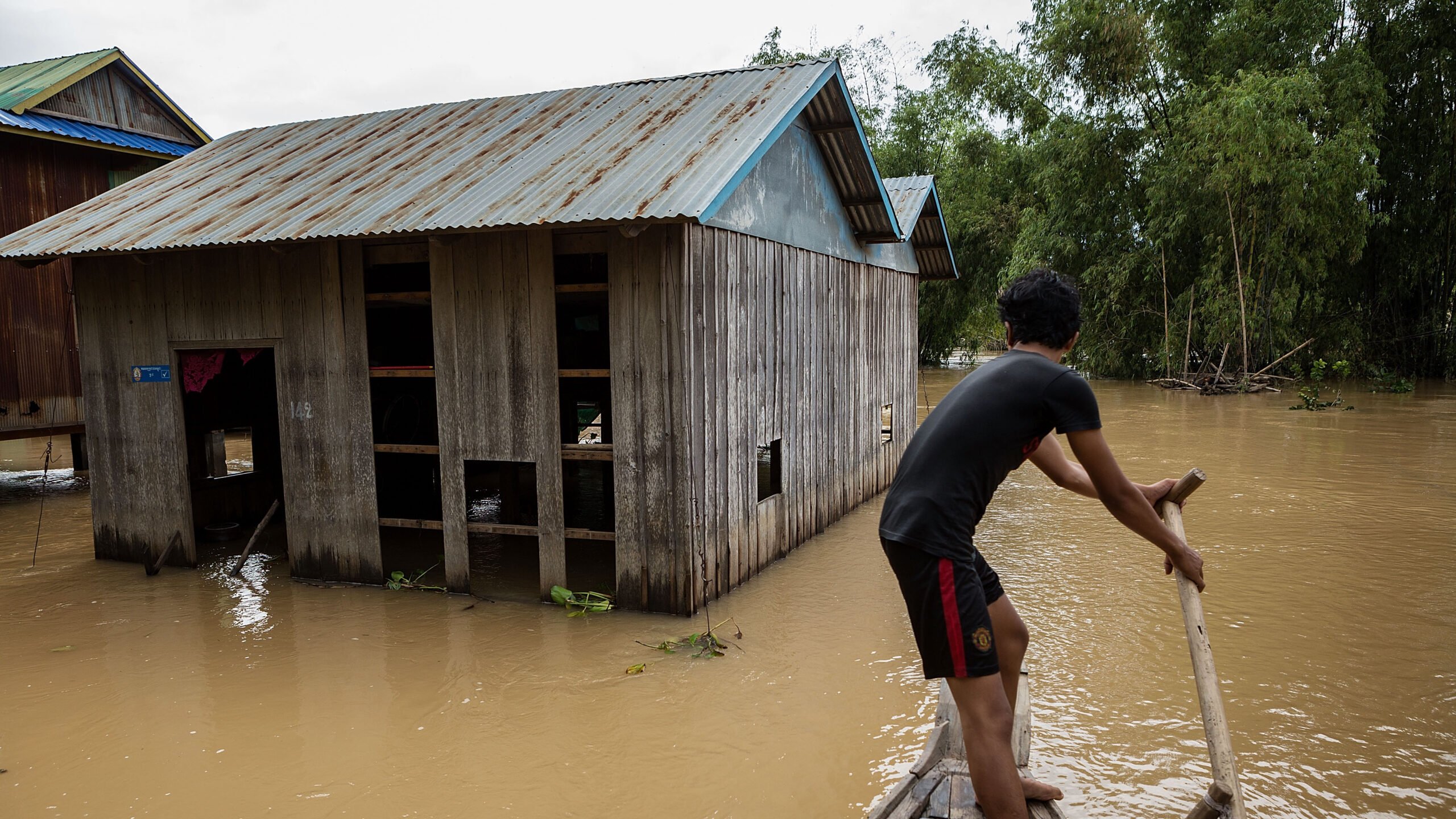
A flooded house in Prek Touch commune, as 500 families are relocated from Tonle Bit commune after the Mekong river broke it’s banks on October 1, 2013 in Kampong Cham Province, Cambodia. (Photo by Nicolas Axelrod/Getty Images)
WASHINGTON: There’s no shortage of near-future fiction in which a lack of water is the source of all mankind’s woes — and, apparently, fire-guitars. But while screenwriters may take artistic license, increasing tensions over water availability is a very real security concern for US analysts and will only get worse if the world fails to address climate change, according to a new intelligence report.
“[A]s temperatures rise and more extreme effects manifest, there is a growing risk of conflict over water and migration, particularly after 2030, and an increasing chance that countries will unilaterally test and deploy large-scale geoengineering — creating a new area of geopolitical disputes,” reads a National Intelligence Estimate on climate change, published today by the Director of National Intelligence.
The 15-page report covers a range of looming climate-related security concerns, from the potential for military conflict in the arctic as the ice cap melts to the lack of dialogue around the aforementioned and sci-fi-sounding “geoengineering,” which refers to methods of artificially cooling the planet. (Movie-lovers will remember that’s how the dystopia of “Snowpiercer,” among others, was born.)
Overall, the intelligence analysts “assess that climate change will increasingly exacerbate risks to US national security interests as the physical impacts increase and geopolitical tensions mount about how to respond to the challenge.”
It should be noted that the analysts who wrote the report said they had “low to moderate confidence” in their conclusions about “how physical climate impacts will affect US national security interests and the nature of geopolitical conflict, given the complex dimensions of human and state decisionmaking.”
The intelligence report was published along with a series of Biden administration climate change reports, including one from the Defense Department, entitled “Climate Risk Analysis,” [PDF]. While the DoD document doesn’t focus on water in particular, it echoes the larger warnings from ODNI, with Defense Secretary Lloyd Austin writing that climate change “touches most of what this Department does, and this threat will continue to have worsening implications for U.S. national security.”
RELATED: With New Plan, Pentagon Embraces Climate Change Fight
According to the ODNI report, should things continue the way they are, “transboundary tensions probably will increase over shared surface and groundwater basins as increased weather variability exacerbates preexisting or triggers new water insecurity in many parts of the world.” The report currently rates that while the potential for water conflict is “low” in 2021, it rises to “medium” by 2030 and to “high” by 2040.
Pakistan, for instance, relies on downstream surface water from “heavily glacier-fed rivers” that originate in rival India’s territory, enough so that Pakistan requires “frequent data from India on river discharges in order to provide advanced warning to evacuate villages and prepare for flooding,” the report says. Considering the tense, often violent relationship between the two nations, it’s not difficult to see how fragile that dynamic is to climate change.
In East Asia, the Mekong River is “already […] an area of growing dispute over dam building, largely by China” because it threatens water used downstream by smaller nations like Cambodia and Vietnam, the report says.
More than half of surface water resources in the Middle East and North Africa are “transboundary and all countries share at least one aquifer,” the report says, citing the World Bank. Already several of those are “vulnerable to salt water intrusion, even from minor rises in sea levels, increasing the potential for conflict.”
More generally the report calls attention to international river basins, some 263 of them, that are sources for water for much of the world’s population, but at least half of them are not run cooperatively. That means that for those, there’s no real mechanism to respond to water-related crises between nations. “[And] most existing agreements are not flexible enough to address disruptions in weather patterns and reduced water flow caused by climate change.” the report says.
Just about the only upside the report’s authors see is that if it gets bad enough, new technologies might emerge to help solve the worst problems — for a cost.
“The need for investments in adaptation technologies to manage water stress and reduce a potential driver of migration could create expanded markets for advanced technologies, such as water storage and reuse systems,” they write. “The UN’s Global Commission on Adaptation calculates that a $1.8 trillion investment by 2030 in early warning systems, resilient infrastructure, dryland agriculture crop production, mangroves, and water resource management would yield more than $7 trillion in benefits in avoided costs from climate change effects.”
F-35 program could reshuffle long-term upgrade plan, deliver TR-3 jets early without full capability
“I’m getting tired of over-promising and under-delivering,” F-35 program head Air Force Lt. Gen. Mike Schmidt said.


























